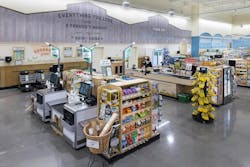The future of grocery store design: It may be time for the checkout aisle to check out
The checkout aisle has always been a source of frustration for both shopper and grocer, alike. For shoppers, the frustration stems from long waits for one of three cashiers, despite there being 15 check-stands. For grocers, the checkout aisle is one of the greatest sources of customer complaints and shrink, which directly affects their bottom line.
Even with advances in point-of-sale (POS) technology and the implementation of self-checkout, these pain points in the grocery shopping experience still persist. The solution to all this may be as simple as eliminating the check-out aisle altogether, drastically altering and improving the grocery shopping experience as we know it for shoppers and grocers.
Much of the infrastructure to make this change is already in place. Many grocers already offer companion apps which customers can use to keep their grocery list, check the store’s weekly ad, and locate items in the store. These apps could also be used to allow customers to scan items as they put them in their cart rather than having to scan their entire order at the checkout. Additionally, grocers can use clever merchandising to incentivize online orders and decrease the volume of shoppers queuing for checkouts.
In a 50,000-sf grocery store, the floorplan is typically divided into 40,000 sf for the sales floor and 10,000 sf for the stock room and prep areas. By flipping this ratio in favor of the stock room and prep areas and moving staple products such as paper products and packaged goods to the stock room, stores can incentivize shoppers to place most of their order online to be fulfilled by store staff. This could greatly reduce the demand for check stands. Even for those shoppers that still prefer to select their own produce, meats, and deli items, the number of items being scanned at check stands would be decreased, reducing wait times.
Grocery store design trends: smart carts, AI-powered cart scanners
Another tactic for grocers to eliminate the checkout aisle and reduce friction for shoppers is implementation of new technologies in their stores. Some grocers, such as Kroger and Alberson’s, have begun piloting smart carts in their stores. Smart carts feature AI-powered technology that recognizes when shoppers add items to their cart and automatically adds the item to the shopper’s order.
While the prospect of replacing a grocer’s entire fleet of carts can seem daunting and expensive, grocers do have options. They can choose to replace their carts altogether or there are modular smart cart options, which grocers can clip on to their current carts.
Both of these options have their advantages. For the modular option, the main advantage is cost and ease of implementation. However, the full-cart option is more efficient. Some of these carts are even able to recognize items as small as a single cherry on top of a full grocery order. In initial pilot programs, these smart carts have been shown to not only reduce the friction experience by shoppers at the checkout aisle, but also reduce shrink as it is far more difficult for the shoppers to fool a smart cart than a self-checkout.
In addition to smart carts, AI-powered cart scanners can also replace traditional checkout aisles. These systems are placed at the store exits and use a camera to capture an image of shoppers’ carts. AI can then use the image to identify the items in the cart and charge the shopper’s store account as opposed to the shopper having to scan every item individually at checkout.
These systems can also be used as loss prevention tools. AI can cross reference the image of the shopper’s cart against their receipt to ensure that every item was paid for. Notably, Walmart is piloting these systems at a handful of Sam’s Club locations as an alternative to receipt checkers.
Rise of the experiential grocery store
The benefits of eliminating the checkout aisle can even extend beyond reduced shrink and customer complaints. This fundamental shift could usher in experiential grocery, where the experience of shopping is the draw rather than a mundane chore. Without the need to staff check-stands, staff can become ambassadors for the store and its brands, providing personal service to each customer and making the shopping experience about the discovery of new and exciting products.
The average U.S. shopper makes eight trips to the grocery store per month. That’s eight times per month that shoppers must spend their precious free time waiting in line to checkout—an experience that, in itself, is not exactly worth waiting in line.
Eliminating or greatly reducing the need for this unpleasant experience can reduce friction between shopper and grocer, making the experience for both parties more efficient and more rewarding. Ultimately, it would help transform the grocery store from a place where shoppers have to be to a place where shoppers want to be.
